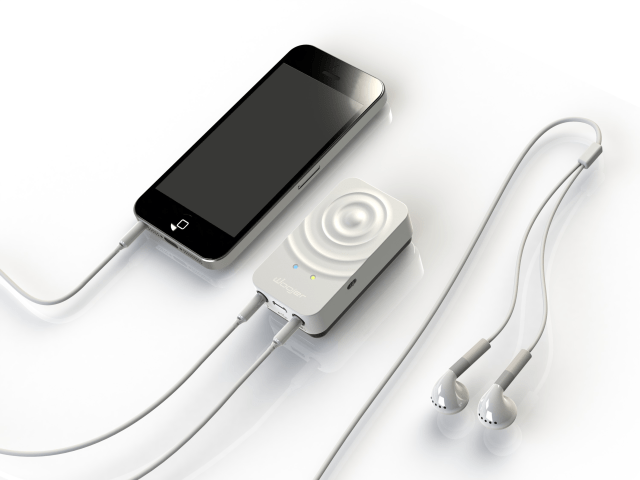
Woojer is a wearable mobile accessory designed to allow its wearer to feel what they’re listening to on their mobile device — via the medium of haptic feedback — rather than simply having banging tunes inserted into their earholes. It’s also being aimed at gamers who want a more immersive in-game experience, or for watching movies or other audiovisual content on a mobile device.
The Israel-based startup behind Woojer, which closed a $600,000 angel round earlier this year, has been developing the product since the start of 2011. It currently has a working prototype — and plans to launch a Kickstarter campaign next month to raise funding for an initial production run. If that’s successful, they hope to ship to backers in early Spring 2014.
How exactly does Woojer work? Its creators describe it as a “tactile transducer” that reproduces sound as a polyphonic vibration, allowing a haptic, noiseless element to augment the standard stereo audio the user hears via their own headphones (which plug into the Woojer box via a 3.5mm headphone jack).
Unlike some of the rival offerings in this space, such as subpac and bassAware Holster, Woojer doesn’t require the user to strap on some form of backpack or wear a special headset. (Or look like they buy all their clothes at Cyberdog.) Instead, the roughly matchbox-sized box is clipped to clothing so it rests against the body. Its low frequency vibrations then create a physical bass sensation — similar to hearing live music at a concert or cinema surround sound. Or that’s the theory.
Here’s how Woojer explains the tech — which it will be showing off next week at Pepcom in San Francisco:
The key Woojer know-how lies in the novel tactile transducer that reproduces sound as a polyphonic vibration. The device has accurate frequency response throughout the sonic and subsonic ranges. Clipped to the clothing along strategic meridian bodylines, the signal synergy convinces the brain that the whole body is exposed to high acoustic energy by the principle of “Perceptual Inference”. The device is compact, low cost, energy efficient and scalable. We have demonstrated both corded and wireless configurations.
“When playing games on smartphones or tablets with headsets the audio experience is two dimensional. With our device you ‘feel the sound’ in a similar manner when in the presence of strong speakers. Users claim it feels like being at a club or in a cinema with surround sound,” adds Woojer founder Neal Naimer.
“The Woojer device can be used in many ways — to give some simple examples: simulators, in games to provide subsonic sensation — unaudible feelings of people walking behind you, earthquakes [etc].”
Advantages over rival offerings in this space include its small size and portability; lower price (final retail price is still being decided but Naimer suggests a ballpark figure of $70 for two devices vs $300 for some rival offerings); polyphonic sound; improved latency over rivals’ so that the tactile sensation doesn’t lag the audiovisuals; and a longer play time (Woojer will be good for more than four hours of use), according to Naimer.
The startup is taking to Kickstarter to push production forward rather than attempting to partner with games or headset makers as a faster way to get to market.
“We can partner with any of the OEMs (both games and headsets) and are in touch with a number, but their decision cycle is proving to be too long for us,” Naimer told TechCrunch earlier this year, adding: “There is no real need for a formal relationship at the outset as we are backwardly compatible with all headsets and all consoles that have a standard audio jack.”
Here’s a video of Woojer’s Naimer pitching the concept earlier this year:

















0 nhận xét:
Đăng nhận xét